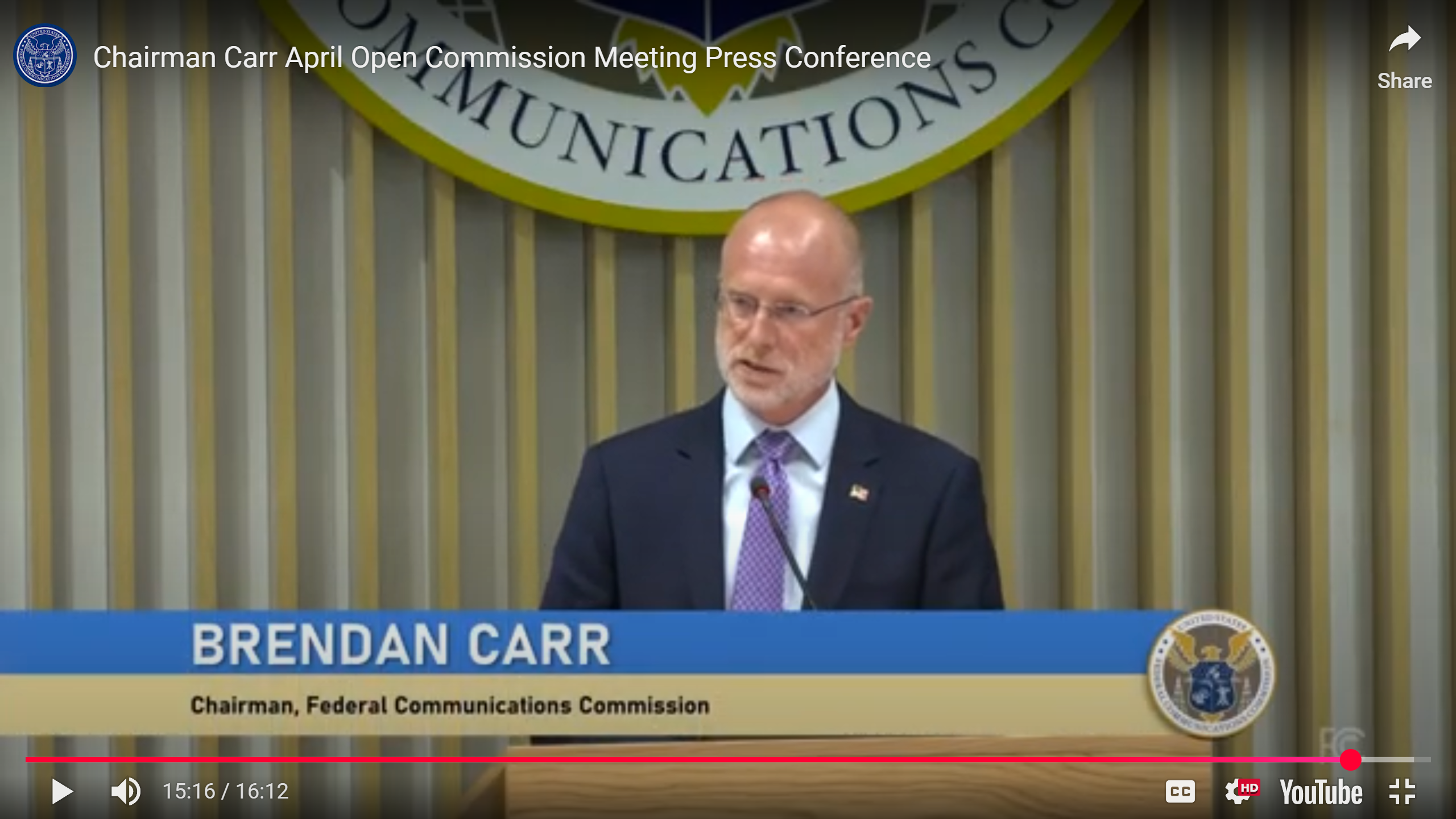ABC to Rock Times Square
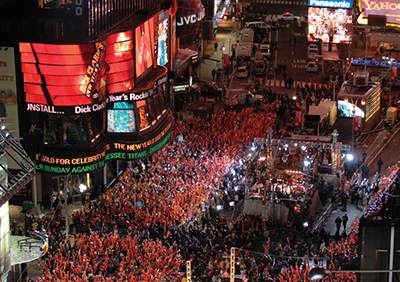
NEW YORK—The late, great Dick Clark is gone, but the show he created 40 years ago will rock on in Times Square on Dec. 31. Ryan Seacrest will host “Dick Clark’s New Year’s Rockin’ Eve” starting at 8 p.m. EST, bolstered by live performances by Carly Rae Jepsen, Taylor Swift and Neon Trees. And, as usual, ABC will field a massive mobile operation to capture the stars and crowds packing Time Square, and feeding the action to the world.
Fortunately for the Disneyowned net, the locale is also home to ABC’s New York studios at the corner of Broadway and West 44th Street. “We also set up a stage on Military Island at West 44th Street with a jib and camera for outside presentation,” said Ellen Zalk, ABC’s director of client services. ABC also deploys shooters with handheld RF cameras to let the host do on-street interviews with the public. “There is also a jib and additional camera on the 7th floor roof of 1500 Broadway for crowd and ball shots,” Zalk said.
ON THE STREET
“Shooting in Times Square surrounded by a crowd of almost 2 two million people has its obvious challenges,” noted Bob Lampel, ABC’s technical manager. Fortunately, “the NYPD does a magnificent job keeping things well organized and providing secure alleys and access for our two roving Steadicam units.” These camera units both are six-person crews with RF camera, RF audio, RF return video and RF prompter.
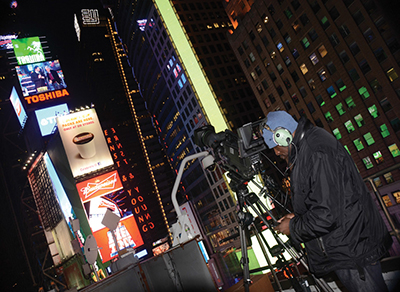
An ABC camera operator on the 7th floor terrace of 1500 Broadway prepares to shoot the “ball” drop. ABC plans to use 12 cameras to cover its talent, guest interviews and the scene in Times Square. According to Lampel, a mix of Sony HDC-1500 and “PMW-500 on sticks” will be used for studio and main stage coverage. Three jibs will be fitted with Sony HDC-1500s; plus two Steadicams with Sony HDC-91s linked via RF transmitters for street interviews. A handheld Sony PMW-500 connected to an RF transmitter will also be deployed, plus an RF-connected PMW-500 with a Fujinon XA101 lens located four blocks from the ball for wide shots.
Audio will be captured using a range of microphones, including VMC cardioid mics, Lectrosonic SMVs with MKE2 gold capsules, and Shure VP88s. Lectrosonic UM400a digital hybrid wireless UHF belt packs will be used as well.
GOING TO AIR
Reliably transmitting video and audio back to ABC’s Times Square studios via RF is a must. “We utilize a system of antennas strategically located around the Times Square grid,” said Lampel. “Some antennas are powered locally, others, where shore power is not available—remember we’re in one of the busiest intersections in the world—receive power through SMPTE fiber. “
The signals travel to and from the base stations, located on the roof of ABC’s Times Square Studios, via a network of fiber-optic cable hung from street lamps and traffic posts in the Times Square area. (Every December, a massive ad hoc fiber-optic network is installed in Times Square to support the event.)
Get the TV Tech Newsletter
The professional video industry's #1 source for news, trends and product and tech information. Sign up below.
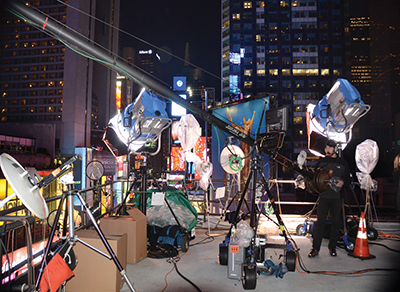
Spotlights point to the crowd on Broadway and Seventh Avenues, above ABC’s Times Square Studios complex. There’s no one proven way to create this data network. In fact, “These systems are a constant work in progress and ongoing conversation at ABC, and continue to evolve year after year,” Lampel said.
The video and audio are ported to two HD control rooms in ABC’s Times Square Studios. Both control rooms are equipped with Sony 8000A switchers, supported by 6-channel EVS media storage units. “The audio consoles are Calrec Sigma in Control A and an API Legacy in Control B,” said Lampel.
AN UNPREDICTABLE SHOOT
Even after four decades, the ABC production team never takes the Times Square remote for granted. This is because New Year’s Eve is one of the most daunting shoots they face annually.
Among the challenges: “Moving around becomes progressively more difficult as midnight approaches, mostly because the crowd has grown to an unimaginable size,” Lampel said. “The PA system needed to cover the area with an endless stream of live music and other events is run at extremely high volume, creating a huge hearing challenge with comms.”
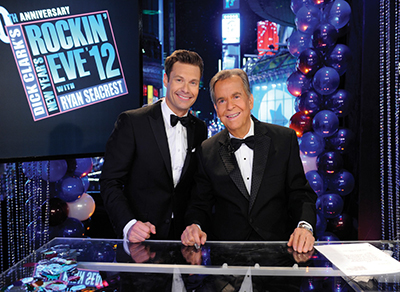
Dick Clark (R) makes his final appearance at New Year’s Rockin’ Eve 2012 with co-host Ryan Seacrest. Then there’s the weather, which affects the crew in the seven day on-site runup to New Year’s Eve. “Needless to say, the elements are unpredictable,” Lampel noted.
Despite the madness, “Dick Clark’s New Year’s Rockin’ Eve” is worth the effort for ABC. Nearly 23 million watched last year’s broadcast, marking an 11-year high for the show—and the last appearance by Dick Clark alongside Seacrest.
Much as Clark will be missed this year, there’s no doubt that his New Year’s Eve Times Square broadcast will continue to draw huge audiences. It’s a likelihood that would have pleased the rock’n’roll broadcast pioneer to no end.
“The bottom line is, it’s a loud, cold, jam-packed yet magnificent environment that is probably the most interesting challenge one can hope to encounter in live TV,” said Lampel. “Everyone is pressing closer to the ball, and the energy in the plaza builds and feels comparable to five Super Bowls at once.”
James Careless is an award-winning journalist who has written for TV Technology since the 1990s. He has covered HDTV from the days of the six competing HDTV formats that led to the 1993 Grand Alliance, and onwards through ATSC 3.0 and OTT. He also writes for Radio World, along with other publications in aerospace, defense, public safety, streaming media, plus the amusement park industry for something different.

